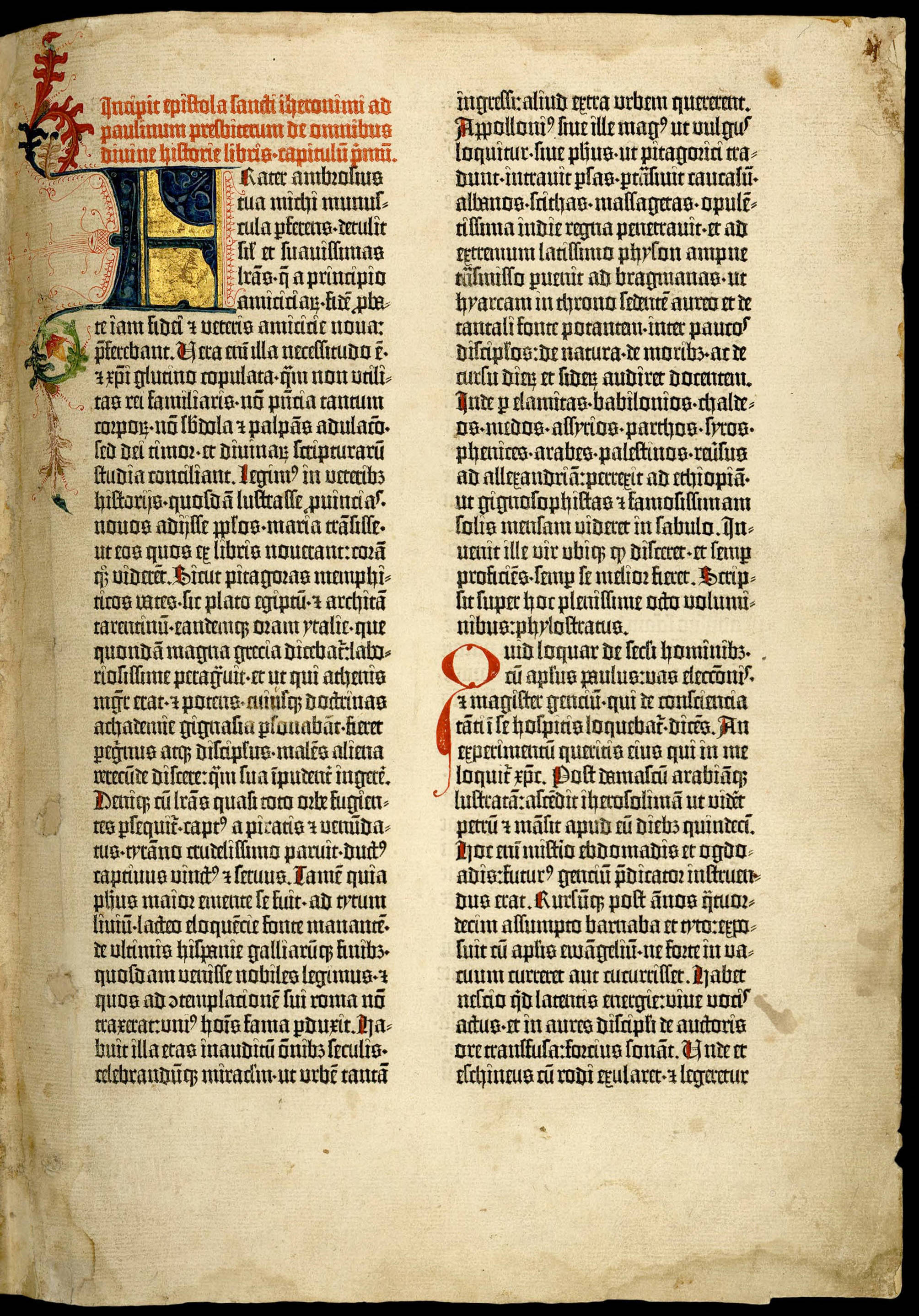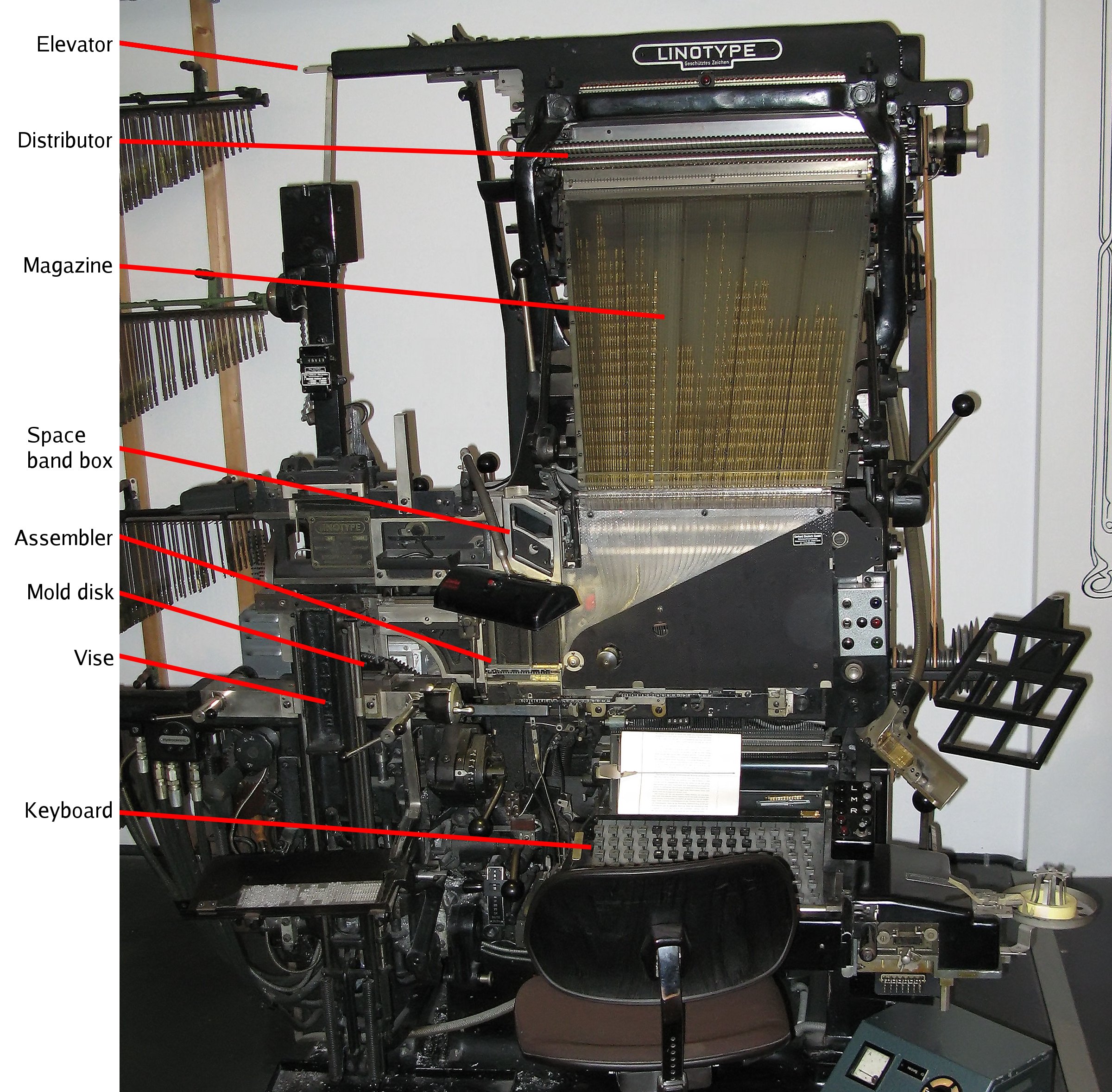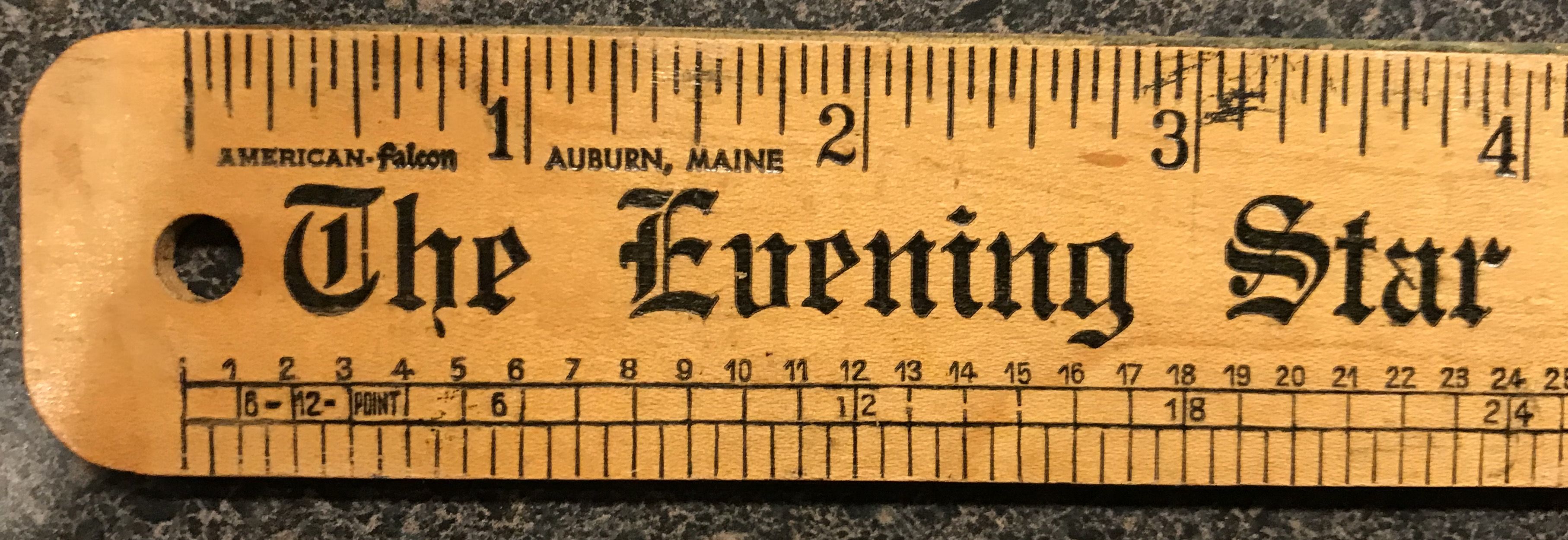|
En (typography)
An en (from English '' en quadrat'') is a typographic unit, half of the width of an em. By definition, it is equivalent to half of the body height of the typeface (e.g., in 16- point type it is 8 points). The en is sometimes referred to as the "nut", to avoid confusion with the similar-sounding "em". The en dash () and en space () are each one ''en'' wide. In English, the en dash is commonly used for inclusive ranges (e.g., "pages 12–17" or "August 7, 1988 – November 26, 2005"), to connect prefixes to open compounds (e.g., "pre–World War II"). The en-dash is also increasingly used to replace the long dash ("—", also called an em dash or em rule). When using it to replace a long dash, spaces are needed either side of it – like so. This is standard practice in the German language, where the hyphen is the only dash without spaces on either side ( line breaks are not spaces ''per se''). History Some sources claim the term "en" was derived from the letter "n", which ... [...More Info...] [...Related Items...] OR: [Wikipedia] [Google] [Baidu] |
En Quad
In typography, a quad (originally ''quadrat'') was a metal spacer used in letterpress typesetting. The term was later adopted as the generic name for two common sizes of spaces in typography, regardless of the form of typesetting used. An em quad (originally ''m quadrat'') is a space that is one '' em'' wide; as wide as the height of the font. An en quad (originally ''n quadrat'') is a space that is one '' en'' wide: half the width of an em quad. Both are encoded as characters in the General Punctuation code block of the Unicode character set as and , which are also defined to be canonically equivalent to and respectively. LaTeX markup uses \quad for an em quad, and has other related whitespace escape sequences. History In 1683, in Joseph Moxon's book on the art of printing, the terms ''m'' and ''n quadrat'' are attested: And as there is three Heighths or Sizes to be considered in Letters Cut to the same Body, so is there three Sizes to be considered, with respect to the ... [...More Info...] [...Related Items...] OR: [Wikipedia] [Google] [Baidu] |
Hyphen
The hyphen is a punctuation mark used to join words and to separate syllables of a single word. The use of hyphens is called hyphenation. The hyphen is sometimes confused with dashes (en dash , em dash and others), which are wider, or with the minus sign , which is also wider and usually drawn a little higher to match the crossbar in the plus sign . As an Orthography, orthographic concept, the hyphen is a single entity. In character encoding for use with computers, it is represented in Unicode by any of several character (computing), characters. These include the dual-use hyphen-minus, the soft hyphen, the #Nonbreaking hyphens, nonbreaking hyphen, and an unambiguous form known familiarly as the "Unicode hyphen", shown at the top of the infobox on this page. The character most often used to represent a hyphen (and the one produced by the key on a keyboard) is called the "hyphen-minus" by Unicode, deriving from the original ASCII standard, where it was called "hyphen(minus)". ... [...More Info...] [...Related Items...] OR: [Wikipedia] [Google] [Baidu] |
List Of XML And HTML Character Entity References
In SGML, HTML and XML documents, the logical constructs known as ''character data'' and ''attribute values'' consist of sequences of characters, in which each character can manifest directly (representing itself), or can be represented by a series of characters called a ''character reference'', of which there are two types: a ''numeric character reference'' and a ''character entity reference''. This article lists the character entity references that are valid in HTML and XML documents. A character entity reference refers to the content of a named entity. An entity declaration is created in XML, SGML and HTML documents (before HTML5) by using the syntax in a document type definition (DTD). Character reference overview In HTML and XML, a ''numeric character reference'' refers to a character by its Universal Coded Character Set/Unicode ''code point'', and uses the format: &#x''hhhh''; or &#''nnnn''; where the x must be lowercase in XML documents, ''hhhh'' is the code po ... [...More Info...] [...Related Items...] OR: [Wikipedia] [Google] [Baidu] |
Non-breaking Space
In word processing and digital typesetting, a non-breaking space (), also called NBSP, required space, hard space, or fixed space (in most typefaces, it is not of fixed width), is a space character that prevents an automatic line break at its position. In some formats, including HTML, it also prevents consecutive whitespace characters from collapsing into a single space. Non-breaking space characters with other widths also exist. Uses Despite having layout and uses similar to those of whitespace, it differs in contextual behavior. Non-breaking behavior Text-processing software typically assumes that an automatic line break may be inserted anywhere a space character occurs; a non-breaking space prevents this from happening (provided the software recognizes the character). For example, if the text "100 km" will not quite fit at the end of a line, the software ... [...More Info...] [...Related Items...] OR: [Wikipedia] [Google] [Baidu] |
Linotype Machine
The Linotype machine ( ) is a "line casting" machine used in printing which is manufactured and sold by the former Mergenthaler Linotype Company and related It was a hot metal typesetting system that cast lines of metal type for one-time use. Linotype became one of the mainstays for typesetting, especially small-size body text, for newspapers, magazines, and posters from the late 19th century to the 1970s and 1980s, when it was largely replaced by phototypesetting and digital typesetting. The name of the machine comes from producing an entire line of metal Sort (typesetting), type at once, hence a ''line-o'-type''. It was a significant improvement over the previous industry standard of letter-by-letter manual typesetting using a composing stick and shallow subdivided trays, called "cases". The Linotype machine operator enters text on a 90-character keyboard. The machine assembles ''matrices'', or molds for the letter forms, in a line. The assembled line is then cast as a sin ... [...More Info...] [...Related Items...] OR: [Wikipedia] [Google] [Baidu] |
United Kingdom
The United Kingdom of Great Britain and Northern Ireland, commonly known as the United Kingdom (UK) or Britain, is a country in Northwestern Europe, off the coast of European mainland, the continental mainland. It comprises England, Scotland, Wales and Northern Ireland. The UK includes the island of Great Britain, the north-eastern part of the island of Ireland, and most of List of islands of the United Kingdom, the smaller islands within the British Isles, covering . Northern Ireland shares Republic of Ireland–United Kingdom border, a land border with the Republic of Ireland; otherwise, the UK is surrounded by the Atlantic Ocean, the North Sea, the English Channel, the Celtic Sea and the Irish Sea. It maintains sovereignty over the British Overseas Territories, which are located across various oceans and seas globally. The UK had an estimated population of over 68.2 million people in 2023. The capital and largest city of both England and the UK is London. The cities o ... [...More Info...] [...Related Items...] OR: [Wikipedia] [Google] [Baidu] |
Compositor (typesetting)
Typesetting is the composition of text for publication, display, or distribution by means of arranging physical ''type'' (or ''sort'') in mechanical systems or ''glyphs'' in digital systems representing '' characters'' (letters and other symbols).Dictionary.com Unabridged. Random House, Inc. 23 December 2009Dictionary.reference.com/ref> Stored types are retrieved and ordered according to a language's orthography for visual display. Typesetting requires one or more fonts (which are widely but erroneously confused with and substituted for typefaces). One significant effect of typesetting was that authorship of works could be spotted more easily, making it difficult for copiers who have not gained permission. Pre-digital era Manual typesetting During much of the letterpress era, movable type was composed by hand for each page by workers called compositors. A tray with many dividers, called a case, contained cast metal '' sorts'', each with a single letter or symbol, but ... [...More Info...] [...Related Items...] OR: [Wikipedia] [Google] [Baidu] |
Newline
A newline (frequently called line ending, end of line (EOL), next line (NEL) or line break) is a control character or sequence of control characters in character encoding specifications such as ASCII, EBCDIC, Unicode, etc. This character, or a sequence of characters, is used to signify the end of a line (text file), line of text and the start of a new one. History In the mid-1800s, long before the advent of teleprinters and teletype machines, Morse code operators or telegraphists invented and used Prosigns for Morse code, Morse code prosigns to encode white space text formatting in formal written text messages. In particular, the International Morse code, Morse prosign (mnemonic break text), represented by the concatenation of literal textual Morse codes "B" and "T" characters, sent without the normal inter-character spacing, is used in Morse code to encode and indicate a ''new line'' or ''new section'' in a formal text message. Later, in the age of modern teleprinters, st ... [...More Info...] [...Related Items...] OR: [Wikipedia] [Google] [Baidu] |
Dash
The dash is a punctuation mark consisting of a long horizontal line. It is similar in appearance to the hyphen but is longer and sometimes higher from the baseline. The most common versions are the endash , generally longer than the hyphen but shorter than the minus sign; the emdash , longer than either the en dash or the minus sign; and the horizontalbar , whose length varies across typefaces but tends to be between those of the en and em dashes. Typical uses of dashes are to mark a break in a sentence, to set off an explanatory remark (similar to parenthesis), or to show spans of time or ranges of values. The em dash is sometimes used as a leading character to identify the source of a quoted text. History In the early 17th century, in Okes-printed plays of William Shakespeare, dashes are attested that indicate a thinking pause, interruption, mid-speech realization, or change of subject. The dashes are variously longer (as in '' King Lear'' reprinted 1619) or ... [...More Info...] [...Related Items...] OR: [Wikipedia] [Google] [Baidu] |
German Language
German (, ) is a West Germanic language in the Indo-European language family, mainly spoken in Western Europe, Western and Central Europe. It is the majority and Official language, official (or co-official) language in Germany, Austria, Switzerland, and Liechtenstein. It is also an official language of Luxembourg, German-speaking Community of Belgium, Belgium and the Italian autonomous province of South Tyrol, as well as a recognized national language in Namibia. There are also notable German-speaking communities in other parts of Europe, including: Poland (Upper Silesia), the Czech Republic (North Bohemia), Denmark (South Jutland County, North Schleswig), Slovakia (Krahule), Germans of Romania, Romania, Hungary (Sopron), and France (European Collectivity of Alsace, Alsace). Overseas, sizeable communities of German-speakers are found in the Americas. German is one of the global language system, major languages of the world, with nearly 80 million native speakers and over 130 mi ... [...More Info...] [...Related Items...] OR: [Wikipedia] [Google] [Baidu] |
Typographic Unit
Typographic units are the units of measurement used in typography or typesetting. Traditional wikt:typometry, typometry units are different from familiar SI, metric units because they were established in the early days of printing. Though most printing is digital now, the old terms and units have persisted. Even though these units are all very small, across a line of print they add up quickly. Confusions such as resetting text originally in type of one unit in type of another will result in words moving from one line to the next, resulting in all sorts of typesetting errors (viz. River (typography), rivers, widows and orphans, disrupted tables, and misplaced captions). Before the popularization of desktop publishing, type measurements were done with a tool called a typometer. Development In Europe, the Didot point system was created by Didot family#François-Ambroise Didot, François-Ambroise Didot (1730–1804) in c. 1783. Didot's system was based on Pierre Simon Fournier's ... [...More Info...] [...Related Items...] OR: [Wikipedia] [Google] [Baidu] |
Compound (linguistics)
In linguistics, a compound is a lexeme (less precisely, a word or Sign language, sign) that consists of more than one Word stem, stem. Compounding, composition or nominal composition is the process of word formation that creates compound lexemes. Compounding occurs when two or more words or signs are joined to make a longer word or sign. Consequently, a compound is a unit composed of more than one stem, forming words or signs. If the joining of the words or signs is orthographically represented with a hyphen, the result is a hyphenated compound (e.g., ''must-have'', ''hunter-gatherer)''. If they are joined without an intervening space, it is a closed compound (e.g., ''footpath'', ''blackbird''). If they are joined with a space (e.g. ''school bus, high school, lowest common denominator''), then the result – at least in English – may be an open compound. The meaning of the compound may be similar to or different from the meaning of its components in isolation. The component stem ... [...More Info...] [...Related Items...] OR: [Wikipedia] [Google] [Baidu] |






